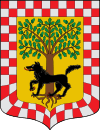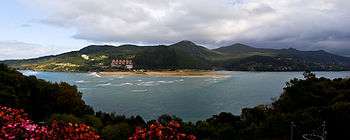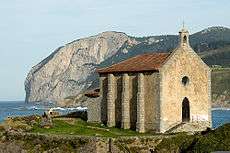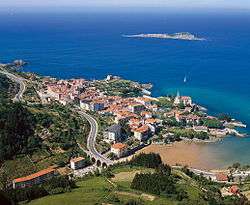Mundaka
| Mundaka | ||
|---|---|---|
| Municipality | ||
|
Mundaka and Izaro Island | ||
| ||
 Mundaka Location of Mundaka within the Basque Country | ||
| Coordinates: 43°24′26″N 2°41′54″W / 43.40722°N 2.69833°WCoordinates: 43°24′26″N 2°41′54″W / 43.40722°N 2.69833°W | ||
| Country | Spain | |
| Autonomous community | Basque Country | |
| Province | Biscay | |
| Comarca | Busturialdea | |
| Government | ||
| • Mayor | Aitor Egurrola Mendiola (EAJ-PNV) | |
| Area | ||
| • Total | 4.15 km2 (1.60 sq mi) | |
| Elevation | 3 m (10 ft) | |
| Population (2014) | ||
| • Total | 1,893 | |
| • Density | 460/km2 (1,200/sq mi) | |
| Demonym(s) | Spanish: mundaqués | |
| Time zone | CET (UTC+1) | |
| • Summer (DST) | CEST (UTC+2) | |
| Postal code | 48360 | |
| Official language(s) |
Basque Spanish | |
| Website | Official website | |
Mundaka (Spanish: Mundaca) is a town and municipality located in the province of Biscay, in the autonomous community of Basque Country, northern Spain. On the coast, Mundaka is internationally renowned for its surfing scene.
Mundaka is accessible from Bilbao by EuskoTren on the Bermeo line.
History
Mundaka is known as one of the most important places of the Lordship of Biscay, it was the birthplace of Jaun Zuria, the first Lord of Biscay, son of the Scottish princess who arrived in Mundaka escaping from an English King. The name of the town has Danish origin, it has been proven that the Vikings arrived there 900 years ago. According to the history of the Lordship, Mundaka has the oldest temple of Biscay, as a result, it has the first seat of the General Parliament.
The port is in the center point of the town, from there the old part of the town grew. All the houses are medieval, fishermen's houses, always looking to the sea.
The anteiglesia of Mundaka was already mentioned in the year 1051 in the donation of the Dominion of Biscay to the Monastery of San Millán de la Cogolla and in 1070 in the donation of the aforementioned church to the Monastery of San Juan de la Peña.

Heraldry
- Shield:The coat of arms of Mundaka is formed by an oak in a gold farm with a wolf, surrounded by a chess game.
- Flag:red silk with gold thread embroidery.
Toponym
There is a well-known legend that attributes the name "Mundaca" to the Latin phrase "munda aqua" ('clean water'). This legend appears in the Chronicle of Biscay written by Lope García de Salazar in the 15th century. According to this story, a ship from Scotland carrying a princess who had been banished from her homeland arrived on the coast of Mundaka. The Scots called the place "in their Latin language" (sic) "Munda aqua" since there they had found a source of very clean water that contrasted with the murky waters of the estuary of Urdaibai. This princess would have a son who would come to be called Jaun Zuria and would become, according to legend, the first Lordship of Vizcaya. This legend may also explain why Mundaca is ranked "first" among the anteiglesias of Biscay.
Apart from legendary explanations, the etymology of Mundaka is uncertain. The first written mention of Mundaka dates from 1070, when it was referred to as "Mondaka".
Ego Mome Nunnuç placuit in animis meis mitto in Sancti Johannis de Orioli de Aragone uno monasterio in Bickaga (Vizcaga) in locum quae dicitur Mondaka (Mondacha)
Some have sought a Norse origin for the name, based on the likely presence of a medieval Viking settlement in the area. In Danish, "mund" means "mouth", and "haka" means "promontory, cape". Mundaka lies precisely at the mouth of the estuary of the same Oka river .
Others have related the name "Mundaca" to a stock of Basque toponyms with the endings "-aka", "-eka", "-ika", which are especially abundant in Biscay and which can be linked with the Celto-Italic suffix "-aka". To some the origin of the name would be much older and it could be traced back to an era in which Vizcaya could have been populated by a Celtic people.
Traditionally the name was written as "'Mundaca"', but nowadays it is more commonly written as "'Mundaka"', which is an adaptation to the modern rules of spelling of the Basque language. Mundaka is usually regarded as the formal name in Castilian and Mundaka in Basque. Since 1982 the official name of the municipality has been Mundaka. The new denomination was published in Boletín Oficial del Estado (BOE) in 1989.
The demonym is "mundaqués / a" in Spanish and "'mundakarra"' Basque.
Mundaca, like Munitibar (Munditibar), stem Munio, Mundio (Muniozguren, Munitiz) which means Hill, hillock. Aka is a suffix known as slope, slope, as also is Ika and Eka. And seeing where Mundaca is located this is very logical: slope of the entangled or the Hill. Note the similarity of Mundi and Mendi, as well meaning a hill and a mountain.

Physical Geography
Mundaca borders to the West with the town of Bermeo, to the South with Pedernales, and to the East and North with the Cantabrian Sea. The island of Ízaro (Bermeo) and the extensive Laida arenal are located off its coast. The municipal area is concentrated around the port, at the feet of Mount Katillotxu (337 m) and the alto de Betrocol.
On the beach in Laidatxu flows the stream Errekatxu.
Its coastal location allows you to enjoy a mild climate both in summer and in winter, with infrequent frost.
Access
- By road: from Bilbao: N-631; from Amorebieta: N-635.
- Railway Bilbao-Bermeo line.
- Bus Bilbao-Bermeo.
- Puerto Mundaka.
- In summer time, a ferry connects the town with the beach of Laida.
Population
The area has been populated since the lower Paleolithic, as attest the caves of Santimamiñe on the other side of the estuary and deposits found in Portuondo.
There are speculations with the arrival in the area of Vikings, who according to some authors justify the presence of blond types of blue eyes on the Basque coast, unlike the Basque type of interior. Anton Erkoreka asserts its presence in the 9th century based on Arabic chronicles, medieval stories and other anthropological data, while Jon Juaristi believed to have actually been a few exiled Saxons dethroned by the Vikings.
Before them the Romans arrived attracted by the marble of Ereño and whose presence bears witness to a branch of Roman roads in Balmaseda that reaches Bermeo.
Since the first census that has news until the 1900s (decade), the population increased reaching 2284 residents in 1910, with different ups and downs due to various avatars of the time. In the 1950s, the population had already dropped to 1500 residents, stabilizing the successive censuses around 1650 inhabitants. Since 1990 the town shows a slight positive trend.
Government
The municipal power while the "immunity of Vizcaya" continued was exercised by the inhabitants. These were the only ones who could adopt ordinances, usages and customs that were to govern themselves, due to their nature of autonomous community and without having to submit to the terms for the granting of the Charter puebla, as happened to the villas. Thus, all mundaqueses, including the widows who were head of the family and could vote, gathered in Assembly or "stop cross" to achieve their agreements, chairing the "' faithful Alderman"'. Between the faculties of the faithful was the representation of the autonomous community in the County Councils of Biscay until they ceased to meet due to the abolition of immunity in 1876. Since then, the post became known as Mayor. Since the transition, the Basque Nationalist Party governs the Town Hall with an absolute majority.
Municipal Elections 2011
Four parties stood in the 2011 municipal elections; EAJ-PNV, Bildu, PSE-EE and PP. These were the results:
- EAJ-PNV: 756 votes (6 Councillors)
- Bildu: 451 votes (3 Councillors)
- PSE-EE: 21 votes (0 Councillors)
- PP: 8 votes (0 Councillors)
This gave PNV control of the council. Bildu, a pro-Basque independence coalition, won 3 seats, while PSE-EE and popular failed to achieve representation due to the low number of votes obtained.
Supramunicipal organizations
- Busturialdea Water Consortium
- Association of Social Services of Biscay
- Regional abattoir
- Committee of mountain farming Guernica-Bermeo – Urremendi
- Board of Trustees of the Urdaibai biosphere reserve
- Association of Basque municipalities – EUDEL
- Center for enterprise development and Industrial of Biscay
- Center of professional initiation Guernica-Bermeo
- Local Charity Board
Economy
- Unemployment: in 1999, there were 58 people registered at INEM, which meant a decrease of 34 per cent over the previous year.
- Primary sector: the village has been fundamentally devoted to the fishing and maritime trade since ancient times, having hosted an important Guild of fishermen. Currently, fishing activity has gone down significantly, leaving no fishermen in the village.
- Secondary sector: the industrial tradition of the locality is non-existent, with the exception of a shipyard, whose lands were destined for the construction of housing at the end of the 20th century. A canning industry was installed in 2002 in Mundaca next to the port of Bermeo. In 2003 the estate Lamiaran with 30.732 m2 of industrial land was opened.
- Tertiary sector: is currently the booster of the economy of Mundaca mainly in summer when the population reaches five-fold. Mundaca has two dozen bars, 8 restaurants and 3 hotels, as well as a campsite of 1st category with "bungalows". The summer season extends during the fall with the arrival of the practitioners of surf.
Distinguished Locals
- Jaun Zuria; According to the legend, first Lordship of VizcayaLord of Biscay.
- Francisco I Earl of Luzarraga, Admiral of the Navy.
- Rodrigo of Portuondo, marine.
- José Manuel Etxeita, writer "euskaldun" and ship's captain. Last Spanish mayor of Manila.
- Ramon Mendezona, historical Communist militant.
- Gregorio Blasco, football goalkeeper.
- Jaime Anesagasti y Llamas, IV Bishop of Campeche (Mexico) in 1910. He was born in Mundaka on 23 May 1863, D. Miguel Antonio de Anesagasti y Llamas (born in Mundaka) and Doña María Antonia Margarita de Jesús Llamas Santoscoy (native of Guadalajara, Mexico). He died 3 October 1910 in Campeche.
- Edorta Jimenez, writer of Basque literature.
- Irati Jimenez, author of Basque literature.
- Bernardo Maria Garro Basterrechea, "Otxolua", writer and translator regarding. Bidegileak
Culture and tourism
Cuisine
The main dish of its kitchen is, by maritime tradition, fish, and especially the bass of Mundaka.
Monuments and unique buildings

- Library, old hospital for pilgrims of the camino de Santiago, traveled by those landing in Bermeo.
- Chapel of Santa Catalina, 19th century, situated on the peninsula that bears its name and the walls that surround it, remains of a Fort of the 19th century.
- St. Mary's Church. Located in the vantage point of the village, with its back to the sea. Its construction began in Romanesque style in the 10th century, but it gives rise to a new Gothic plant in the 16th century after its destruction. Its interior is of an undeniable artistic value. A nave and three equal sections to cover, surely a neoclassical and neo-Gothic Tower of the 19th century.
- Cross of Kurtzio: 17th century, located in the square that bears its name.
- Society Fraternity Mundaquesa (casino).
- Palace of Larrínaga.
- Old town, next to the port.
- Town Hall.
Natural spaces
- Located in the north end of the Biosphere Reserve of Urdaibai, the town has two exceptional viewpoints in the high part if Portuondo and the vantage point of the towne, from which you can see the sands and the mouth of the Mundaka estuary. This is the starting point of the path which goes back the up to estuary Guernica.
Sports
Surfing
Mundaka is well renowned world wide for its quality of surf. Huge swells roll in from the Bay of Biscay and slam into the rocky coastline of the Basque Country. The estuary at Mundaka has created a perfect sandbar which forms hollow waves that can be watched from the town's harbor wall. Mundaka was formerly one of the sites of the World Championship Tour of Surfing.
Some great surfers have marked their legacy on Mundaka such as Andy Irons, Taj Burrow, Bobby Martinez, Kelly Slater, Mark Occilupo and Joel Parkinson.
Parties and events
- Carnival Sunday – "Aratuste".
- 23 June-midsummer or Sanjuanada, bonfire and burning of the witch serving ancestral rites prior to Christianity to the sound of the txistu.
- 29 June – San Pedro, feast.
- 22 July – Magdalena.
- Last week of August – "Euskal Jaia" (Basque party): costumes, craft market, music, exhibition of Basque rural sports ("Herri-kirolak"), Basque "pelota", etc.
- 1 November – Txakoli day.
- 25 November – Catherine party Isla de Santa Catalina.
References
Bibliography
- Ruiz de Azua, Ander. Mundaca. Orígenes Históricos
- Ayuntamiento de Mundaca
External links
- City council web page
- MUNDAKA in the Bernardo Estornés Lasa - Auñamendi Encyclopedia (Euskomedia Fundazioa) (Spanish)
- YOUTUBE video of surf in Mundaka
- YOUTUBE Incredible tubes in Mundaka
- & hl = es & q = Mundaka & ie = UTF8 & z = 14 & ll = 43. 407355, - 2.698345 & spn = 0. 042464, 0.107975 & t = k & om = 1 Mundaka in Google Maps
- Mundaca photos
- Surf in Mundaka

